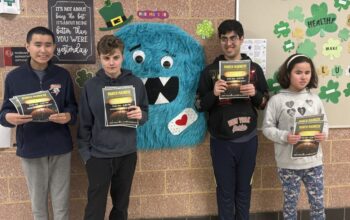Emily Gaeta, Reporter
@emilygcourant
If you walked into a classroom now you would see many students actively using their personal computers as most teachers have students use their devices to take notes or to hand in assignments.

However, Library Department Chair Michelle Luhtala along with a team of volunteer students are looking to change how we use technology in education with the help of Virtual Reality, which provides a fully immersive, 360-degree virtual experience. A VR room was added to the library in 2015 and has been used by students and teachers ever since.
Ms. Luhtala believes the VR system has greater applications than just in the classroom. “Students that graduate from this high school with experience in this kind of technology will be better prepared for whatever comes next whether that be college or career,” she said. “There are so many careers and prototypes, from pilots to police to military training and even car testing. There are so many careers in which this technology is a part of how people learn and how they try out their work and their prototypes.”
Although the VR system has applications in the real world, there are also a lot of ways to use it in the classroom. “One intention of the VR system is to incorporate it into the curricular environment of the library,” junior Casey McCall said.

One program Ms. Luhtala is encouraging is Tilt Brush, a program that lets you draw and paint in 3D. “It’s very powerful, and we have so many projects where kids are designing a layout of a museum or an exhibit, so that has amazing potential,” Ms. Luhtala said “You can create your whole museum exhibit in this space, justify it, and then publish it to something called Cospaces.” Cospaces allows anyone to view what you created in Tilt Brush, giving other students access to their peers work simply by clicking on a link.
“I really believe in the future of Virtual Reality,” Ms. Luhtala said. “We’ve had science classes come down and take a step into the virtual lab to pull the skeletal system and the muscular system apart and then put it back together.”
Extracurricular programs such as the Science Team even use this technology in their weekly meetings. “There’s a bunch of programs that give you a tour of the human body, giving you a lot of valuable information, we’ve used that same program for the science team,” Casey said.
Despite early success, Ms. Luhtala believes the full potential for the VR system has yet to be reached. “We still have room for growth. We have introductory success, we have potential, we have some enthusiastic teachers and we have some vision as to where this can go next,” she said.



